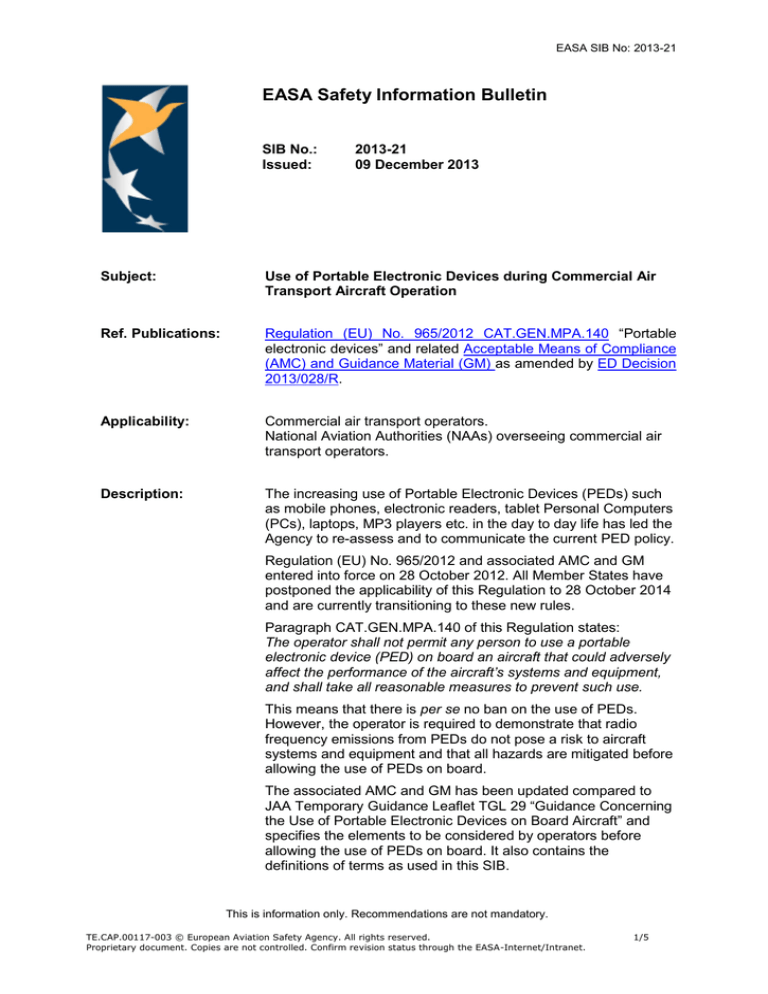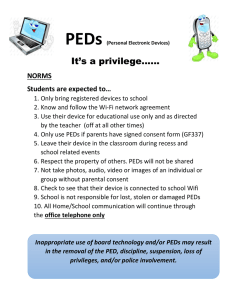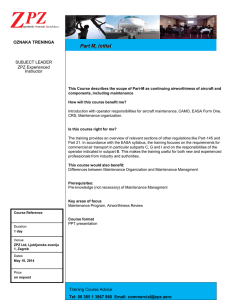
EASA SIB No: 2013-21
EASA Safety Information Bulletin
SIB No.:
Issued:
2013-21
09 December 2013
Subject:
Use of Portable Electronic Devices during Commercial Air
Transport Aircraft Operation
Ref. Publications:
Regulation (EU) No. 965/2012 CAT.GEN.MPA.140 “Portable
electronic devices” and related Acceptable Means of Compliance
(AMC) and Guidance Material (GM) as amended by ED Decision
2013/028/R.
Applicability:
Commercial air transport operators.
National Aviation Authorities (NAAs) overseeing commercial air
transport operators.
Description:
The increasing use of Portable Electronic Devices (PEDs) such
as mobile phones, electronic readers, tablet Personal Computers
(PCs), laptops, MP3 players etc. in the day to day life has led the
Agency to re-assess and to communicate the current PED policy.
Regulation (EU) No. 965/2012 and associated AMC and GM
entered into force on 28 October 2012. All Member States have
postponed the applicability of this Regulation to 28 October 2014
and are currently transitioning to these new rules.
Paragraph CAT.GEN.MPA.140 of this Regulation states:
The operator shall not permit any person to use a portable
electronic device (PED) on board an aircraft that could adversely
affect the performance of the aircraft’s systems and equipment,
and shall take all reasonable measures to prevent such use.
This means that there is per se no ban on the use of PEDs.
However, the operator is required to demonstrate that radio
frequency emissions from PEDs do not pose a risk to aircraft
systems and equipment and that all hazards are mitigated before
allowing the use of PEDs on board.
The associated AMC and GM has been updated compared to
JAA Temporary Guidance Leaflet TGL 29 “Guidance Concerning
the Use of Portable Electronic Devices on Board Aircraft” and
specifies the elements to be considered by operators before
allowing the use of PEDs on board. It also contains the
definitions of terms as used in this SIB.
This is information only. Recommendations are not mandatory.
TE.CAP.00117-003 © European Aviation Safety Agency. All rights reserved.
Proprietary document. Copies are not controlled. Confirm revision status through the EASA-Internet/Intranet.
1/5
EASA SIB No: 2013-21
The AMC is further updated by ED Decision 2013/028/R. It now
foresees that an operator may allow the use of non-transmitting
PEDs during any phase of flight. Non-transmitting PEDs include
all devices for which the transmitting functions (e.g. WLAN,
mobile phone functions, Bluetooth) are disabled.
This SIB provides short term guidance to operators when
intending to expand the use of non-transmitting PEDs.
Subsequent EASA rulemaking in the area of aircraft operations
(OPS) and initial airworthiness will address the issue further,
including for transmitting PEDs (T-PEDS). Nevertheless, this
document also includes some initial recommendations for
T-PEDs.
Recommendation(s):
1) Applicability:
The Agency recommends to use the AMC/GM to
CAT.GEN.MPA.140 also when demonstrating compliance with
EU-OPS/JAR-OPS 3 paragraph 1/3.110, since the requirement
CAT.GEN.MPA.140 itself has not changed compared to
EU-OPS/JAR-OPS 3.
2) General:
Before allowing the expanded use of non-transmitting PEDs on
board, operators are expected to carry out a hazard identification
and to manage identified risks (ref. ORO.GEN.200 (a)(3)). Apart
from the items mentioned in AMC1 CAT.GEN.MPA.140, an
operator should address in particular the following points:
a) The spurious emissions from PEDs as received by the aircraft
antennae can potentially lead to misleading information. It is
recommended to address the following points explicitly:
Low visibility operation interference risk, if such operation is
foreseen. EASA recommends not to allow PED use during
those phases unless dedicated mitigation strategies are in
place:
EUROCAE/ED-130 “Guidance for the Use of Portable
Electronic Devices (PEDs) On Board Aircraft” provides
acceptable processes for assessing and mitigating the
“front-door” interference effects.
RTCA/DO-307 “Aircraft Design and Certification for
Portable Electronic Device (PED) Tolerance” Section 4
also addresses the “front-door” interference effects.
Contrary to the industry standards mentioned above, EASA
recommends to establish the phases of flight as follows:
Approach and Landing: From Initial Approach Fix (IAF) to
visual reference, landing, and after leaving all active
runways.
Taxi to Gate: Begins when the aircraft has crossed all
active runways and concludes when the aircraft is parked
for passenger unloading.
This is information only. Recommendations are not mandatory.
TE.CAP.00117-003 © European Aviation Safety Agency. All rights reserved.
Proprietary document. Copies are not controlled. Confirm revision status through the EASA-Internet/Intranet.
2/5
EASA SIB No: 2013-21
b) Transmitting PED (T-PED) switched-off / transmitting functions
disabled: Passengers are required to switch off the T-PED or
to disable its transmitting functions at the start of the flight
when the passengers have boarded and all doors have been
closed, until a passenger door has been opened at the end of
the flight.
Note: Some aircraft are equipped with systems that enable the
use of T-PEDs. The authorisation of these systems and the
use of T- PEDs in combination with those systems are outside
the scope of this SIB.
c) PED stowage should be considered during critical phases of
flight and taxiing to prevent possible injuries from projectiles
and to allow for egress from the aircraft. Operators should
ensure compliance with AMC1 CAT.OP.MPA.160. Operators
should clearly identify the phases of flight in which PEDs are
to be stowed and determine suitable stowage locations, taking
into account the PED’s size and weight.
d) The passenger briefing is important for providing information
to passengers on the safety aspects, such as egress from the
aircraft in case of an evacuation, demonstrations of safety and
emergency equipment and aircraft systems, etc. It is
recommended that PED distraction during the passenger
safety briefing is avoided so that passengers’ attention
concentrates on the safety briefing and crew instructions.
e) The operator is reminded of the briefing requirements of
CAT.OP.MPA.170 and associated AMC material.
Communication to passengers should be clear and concise.
f) EASA recommends that operators provide general information
on their PED policy to passengers before the flight. This
information should clearly specify at least the following:
i.
which PEDs can be used/are not to be used throughout
the flight/during critical phases of flight and taxiing;
ii.
if, when, and where PEDs are to be stowed during
critical phases of flight and taxiing; and
iii.
that the instructions of the crew are to be followed at all
times.
EASA recommends to the operator to use uniform information
in terms of terminology to avoid passenger confusion.
It is the Agency’s endeavour to harmonise PED policies as
much as possible to avoid passenger confusion. However, it is
generally expected that, as each operator rolls out his
process, the PED policies will become increasingly different.
The information to passengers should therefore reflect the
specific boundaries set by the individual airline policy.
g) Operators should reflect their changed procedures in the
operations manual and brief or train flight crew, cabin crew
and technical crew before an expanded use of PEDs is
implemented.
This is information only. Recommendations are not mandatory.
TE.CAP.00117-003 © European Aviation Safety Agency. All rights reserved.
Proprietary document. Copies are not controlled. Confirm revision status through the EASA-Internet/Intranet.
3/5
EASA SIB No: 2013-21
Such procedures and crew members briefing or training
should specify:
i.
PEDs that can/cannot be used on-board;
ii.
at which times PEDs are to be switched-off, can be
turned on, or can be in non-transmitting mode;
iii.
at which times PEDs can/cannot be used;
iv.
if, when, where, and how PEDs are to be stowed;
v.
to which aircraft/fleet this policy applies;
vi.
continuous update on the PED market development
as far as it concerns the operator’s PED policy.
The expanded use of PEDs should be reflected in the normal,
abnormal and emergency procedures for flight crew, cabin
crew and technical crew. The procedures should include
instructions on how to recognise, respond to and report
suspected or confirmed PED interference events. The
procedures should clearly specify the cabin crew
responsibilities and procedures concerning the use of PEDs,
taking into account that cabin crew will not be able to
physically check the transmission status of each PED carried
by passengers and will not be able to move around the cabin
during certain phases of flight to enforce the operator’s
procedures. The operator should assess and address crew
resource management and workload issues for all crew
members, including passenger information and handling.
h) To monitor the application of the expanded use of PEDs,
EASA recommends that operators should report PED events
to their competent authority. Such events could be linked to
suspected or confirmed PED interference, passenger
handling, smoke or fire caused by a PED.
i) It becomes more and more difficult to distinguish between
devices being transmitting, having transmitting functions
disabled, or being non-transmitting at all. Therefore, EASA
recommends to commercial air transport operators to evaluate
their aircraft as being T-PED resistant, considering the most
commonly used transmitting technologies, or to clearly
communicate to passengers that T-PED use is still restricted.
3) Transmitting PEDs:
AMC1 CAT.GEN.MPA.140 provides a way for operators to allow
the use of transmitting PEDs (T-PEDs) such as mobile phones,
WLAN or Bluetooth devices, during non-critical phases of flight,
excluding taxiing, if the aircraft is certified accordingly, e.g. as
PED tolerant, phone tolerant, having WLAN installations, etc.
a) EASA considers that the method of basing T-PED
assessment purely on the aircraft HIRF (High Intensive
Radiated Fields) compatibility leaves the risk of several
aircraft system malfunctions, as the HIRF certification does
not cover all aircraft systems using appropriate radiation
This is information only. Recommendations are not mandatory.
TE.CAP.00117-003 © European Aviation Safety Agency. All rights reserved.
Proprietary document. Copies are not controlled. Confirm revision status through the EASA-Internet/Intranet.
4/5
EASA SIB No: 2013-21
levels when considering on-board transmissions. EASA
therefore recommends performing the additional assessment
as described in EUROCAE ED-130 Section 4 and related
annexes. Effects known to result from transmitting devices
and having operational consequences are not sufficiently
addressed when using HIRF compliance only.
b) EUROCAE ED-130 provides processes for assessing and
mitigating both the “back-door” interference effects caused by
T-PED transmissions as well as the “front door” interference
effects of spurious emissions from all PEDs. As alternative
method to EUROCAE ED-130, EASA would accept the use of
RTCA/DO-307, Chapter 3 and 4, which can be applied during
aircraft development for PED tolerance certification or
followed subsequently to demonstrate PED tolerance.
c) To support industry, EASA has established the possibility to
develop changes to aircraft for PED compatibility
assessment, which may result in changes to the
documentation only, in case no necessary change to the
aircraft configuration is identified during the project.
Furthermore, a voluntary Special Operational Evaluation
process has been created allowing the review e.g. of reports
demonstrating the compatibility of Controlled-PED (C-PED)
with certain aircraft environments.
d) The Agency reminds to consider the applicable
telecommunication regulations before allowing the use of
transmitting functions on-board aircraft.
Contact(s):
For further information contact the Safety Information Section,
Executive Directorate, EASA. E-mail: ADs@easa.europa.eu.
This is information only. Recommendations are not mandatory.
TE.CAP.00117-003 © European Aviation Safety Agency. All rights reserved.
Proprietary document. Copies are not controlled. Confirm revision status through the EASA-Internet/Intranet.
5/5


